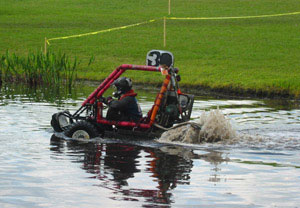 |
|
||
|
|||
ENG off-road warriors maneuver a successful showing in Mini Baja
By Brian Fitzgerald
|
|
|
| Ross Kenyon (ENG’04) takes a jump as part of the endurance race. He was more successful than in the previous lap, when the vehicle rolled at the same ramp. Photo by Julio Otazo |
|
Designing a work of engineering is similar to beginning a work of art.
It starts in the imagination and the mind. But like a piece of art, it’s
a work in progress, with a form that evolves bit by bit before it’s
ready for a gallery — in this case the mud-splattered gallery that makes
up the college cult of mini Baja racing enthusiasts.
Ross Kenyon (ENG’04),
a Picasso with a welder’s torch, and
a member of the BU chapter of the American Society of Mechanical Engineers,
headed a team of nine ENG students who built a vehicle that won several
accolades in a recent intercollegiate competition among fanatical off-road
warriors who construct and drive the mini Baja. The vehicle can best
be described as an automotive racer that is halfway between a go-cart
and a dune buggy, and is named after the larger Baja four-wheeler that
is raced in Baja California, in the Mexican peninsula’s desert
region.
Kenyon and companions took first place in a field of 50 colleges
in the maneuverability event at the National Society of Automotive Engineers
annual Mini Baja East Competition from April 4 to 6 in Orlando, Fla.
Although they didn’t win the whole enchilada (Montreal’s
Ecole de Technologie Supérieure was the top school), the BU gearheads
did manage to enjoy the sweet taste of success, finishing 2nd in the
mud bog event, and 18th overall — no small accomplishment for a university
that doesn’t have an automotive engineering program and had never
entered such a competition.
“
I was pleased with our teamwork, and I look forward to doing even better
next year,” says Kenyon, who must have motor oil pumping through
his veins. As a child he built remote-control cars, “and I also
remember taking apart the family’s leaf blower when it broke,” he
says. After taking an automotive technology course in high school, and
landing a part-time job as a lawn-mower mechanic as a teenager, Kenyon
began to work seriously on his own car, putting in a new engine and rebuilding
the suspension. “When I did well on my SATs, my parents rewarded
me by buying me welding tools,” he says. His “toy” collection
— add a generator, an air compressor, and a plasma cutter — got bigger
and bigger.
“
A plasma cutter is pretty much the handiest tool you can have,” he
says. “It’s a torch that is like a 30,000-degree pencil— it
cuts through any kind of metal.” With enough “pencil” strokes,
imagination, and determination, one can build a car, and that’s
exactly what Kenyon and his BU teammates did. The object of the Mini
Baja Competition is to provide students with a challenging project that
requires the planning and manufacturing tasks involved in introducing
a new product to the consumer industrial market. They must not only design,
build, test, promote, and race the mini Baja, but also generate financial
support for their project, an area, Kenyon says, where ENG was extremely
helpful. The BU team was able to use a machine for milling (cutting metal)
at the Fraunhofer Center for Manufacturing Innovation at BU on Saint
Mary’s St., where the vehicle was stored until the competition.
|
|
|
|
Part of a Sunday drive for Ross Kenyon (ENG’04) included a quarter-mile trip across a pond. Photo by Julio Otazo |
|
Built
around a 10-horsepower Intek Model 20 engine donated by the Briggs & Stratton
Corporation, the BU mini Baja was towed down to Orlando on a boat trailer.
The vehicle, with a birdcage structure above the driver for safety and
fat tires ideal for off-road racing, finished first in the land maneuverability
event, which Kenyon says involved “tight, weaving turns around
a series of cones spread out in a 180-by-60-foot dirt lot.” Once
the green flag dropped, he hit the gas and “set the course record
in qualifying, and went on to win by two seconds in the finals,” he
says.
The vehicles were also tested for acceleration, towing, and suspension,
involving “a rough quarter-mile-long course that is designed to
essentially destroy the mini Baja,” Kenyon says. “It was
also tested for endurance in a four-hour-long race through a very bumpy
palmetto forest. I rolled over once on a jump, but the mini-Baja is specifically
designed for safety — I was in a four-point racing harness.” And
if the car, and Kenyon, weren’t battered enough, they also went
through a 65-foot-long track of mud.
Kenyon wasn’t the only BU student
who took a tumble. In the water maneuverability event, the BU mini Baja
capsized when driver Mike Schumann
(ENG’06) leaned too much into a turn. “It looked like he
was windsurfing,” says Kenyon. “We didn’t receive any
points in that event, but the car wasn’t harmed.”
What about
Schumann? “Oh, he was fine,” says Kenyon. “But
what he did resulted in the implementation of a new safety rule in the
competition: drivers now cannot lean out of the car to aid in steering.”
In
the end, both drivers were fortunate, because BU’s mini Baja
team operates under the same unwritten rule as the other 49: if you trash
the vehicle, you’re the one who has to fix it.
The intact BU entry
will be on display in the lobby of ENG’s manufacturing
engineering department at 15 Saint Mary’s St. until May 1.
![]()
25
April 2003
Boston University
Office of University Relations

